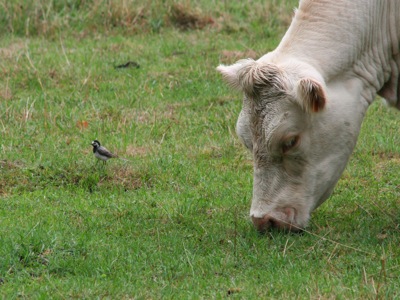The Ants and The Basket Ball
It’s now time to get back to the original question, “does the way we perform the measurement matter?”
Presumably, the theories established by teams C, Q and R will not always predict the same thing, since they are so different. What if we studied the movement of the ants on a small round object, like a basket ball, instead of studying their movement on the floor?
Members of team R observed that on a curved floor, if one walks one step forward, one step left, one step backwards and one step right, the point where you return is not exactly where you left. This little four steps dance can tell us if you walk on a flat surface (if you return where you left) or not (if you don’t).
Let’s try this on the ball, following a quarter of the circumference. Starting at the pole, walk a quarter of a circumference forward: you reach the equator. Walk left a quarter of a circumference, you are now at another point of the equator. Walking back brings you back to the pole. Finally, walking right from there brings you on the equator, a quarter of a circumference away from the pole you started from.
So, is that it? Did we just prove that team R was right all along? Well, not quite. There is a curvature, all right. But is that the curvature that team R predicted, the one that guides the ants to the honey? Hardly so. Now, team R has another curvature to account for, one that seems quite independent from the curvature they imagined was guiding the ants towards the honey. So they have a useful tool (the notion of curvature), but it does not solve everything.
This is a rough analogy, but general relativity faces this issue with non-gravitational forces. This is the issue Albert Einstein tried to solve for the last years of his life, looking for a unified theory of gravitation and electromagnetism.
Do teams C or Q fare any better? Well, they both did not really consider curvature to start with, so it’s not any easier for them. Team C cannot really tell how the hypothetical rubber bands are supposed to bend, nor whether curving them would change how much they pull.
As for team Q, they just can’t agree among themselves on how the sheet of graph paper should be mapped onto the surface of the ball. Some among them try to see what happens if they just keep a flat sheet of paper tangent to the ball’s surface. Near the contact point, it seems to work relatively well, but as you look farther and farther, things diverges pretty badly.
Remember, these are only analogies, but they teach us something about the problem of unifying physics theories. What the basket ball tells us is that theories are only a model of the world. The first thing that unites them is the physical reality. Even if theories agree with one another in some cases (like the flat floor), they may disagree in other cases (the basket ball), and they may even all be wrong.

Does Scale Matter?
Saturday, November 18, 2006

